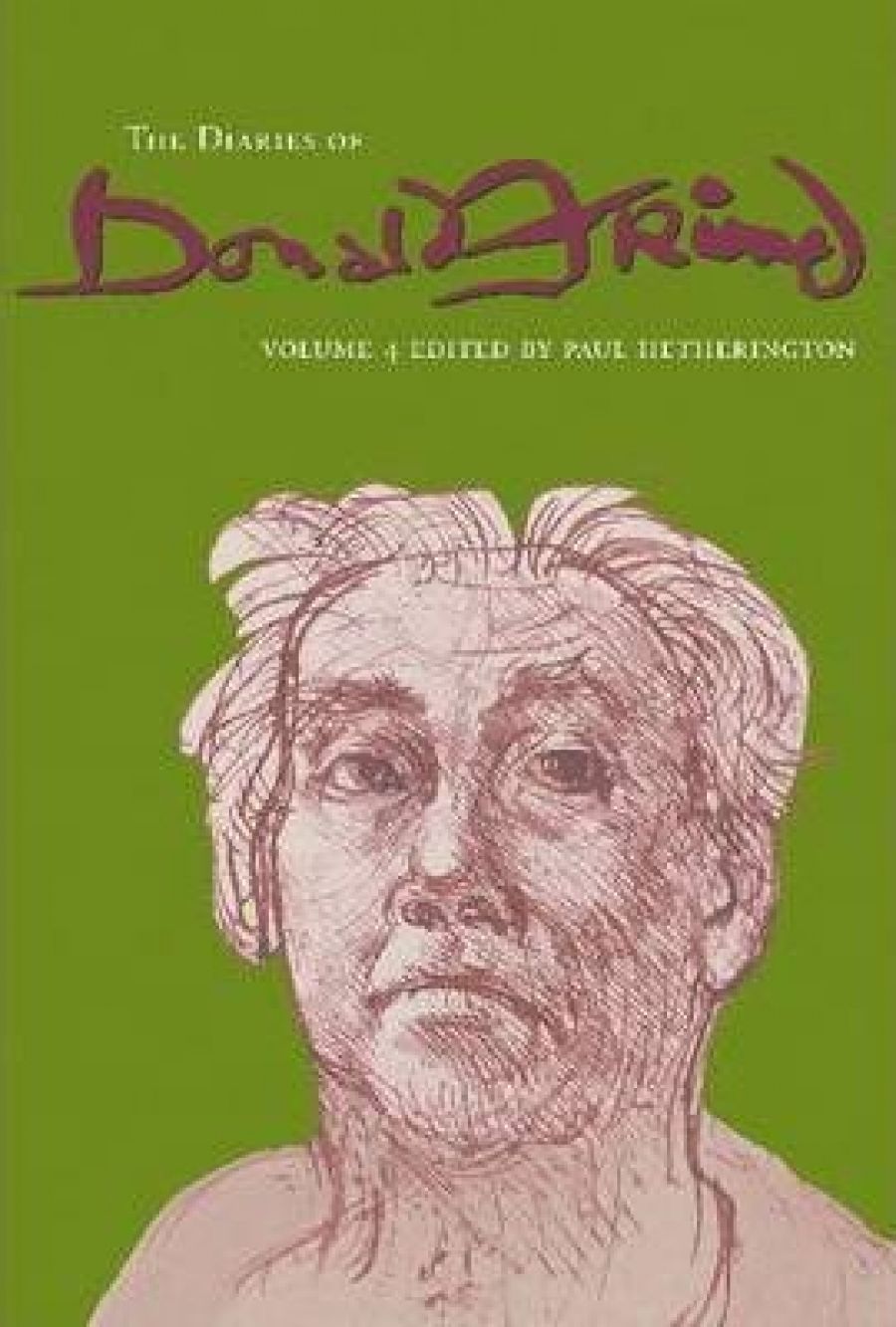
- Free Article: No
- Contents Category: Diaries
- Review Article: Yes
- Online Only: No
- Custom Highlight Text:
The final volume of the diaries of Donald Friend covers the years from 1966, when he was fifty-one, to 1988, the year before his death. For a little over half this period (represented by more than two thirds of the diary entries), Friend lived in Bali. He did so in some splendour, waited on by a retinue of houseboys and visited by the distinguished and the celebrated. This was before mass tourism. There are extensive descriptions of Balinese life – the people, their customs, the religious festivals – and of the ancient monuments. These are of interest, but there is little of Friend in them. He could have been writing a travelogue. There is much on his collecting expeditions for Balinese artefacts, his property developments and his problems with thieves. It is not the quotidian nature of these activities which is the problem. A skilful diarist allows us to see the mundane afresh, through his or her peculiar lens. Here, again, Friend seems to have gone missing.
- Book 1 Title: The Diaries of Donald Friend, Vol. 4
- Book 1 Biblio: National Library of Australia, $59.95 hb, 712 pp
Paul Hetherington, in his introduction, alludes to this problem. He says that the people of Bali never really come into focus. ‘It is as if he never really came to terms with the Balinese after all; as if on some crucial level of understanding, they remained for him indeterminate and dreamlike.’ There is a danger that the sheer scale of Friend’s diaries determines the critical response. They comprise about two million words, of which half has now been published. Friend’s effort was so monumental that it is assumed the quality must be commensurate. Friend himself commented on this attitude when he wrote, on 30 November 1987, of a Fred Williams retrospective, that there was in Australia a ‘comical inclination to regard a large canvas as a “major work”. Size is most important. Fred Williams might well be commended for his acreage.’
The Bali diaries should have been severely pruned. There are some superb entries, but they are few and far between. It is noteworthy that the Bali diaries are not illustrated in the manner of earlier diaries, where the drawings are an integral part of the narrative, forming a modern illuminated manuscript. Perhaps Friend needed this discipline. In May 1982, now back in Australia, he started a new notebook. ‘I shall attempt to revive something of the spirit of those earlier diaries full of drawings and letters and the excitement of life.’ He does attempt it and succeeds – immediately.
Friend is wrong when he writes that an interesting life makes an interesting diary. Such a life is neither necessary nor sufficient. What matters is the skill with which the diarist can evoke ‘the inexplicable punishment, the endless wonder of being alive’, as Miles Franklin put it. In February 1984, Friend wrote:
I think, when this book is full, I shall cease keeping a diary. My life is not interesting enough to justify it. The revelations in these pages show a sick old man whose talents decay with his body: whose reactions to daily existence are boredom and selfdisgust: who feels for people a weary indifference or outright dislike; whose loving warmth is reserved for very few.
But to create a portrait of declining, cantankerous old age, with insight and wit, as Friend does, is a rare gift given to only the first rank of diarists. ‘So old feeling’, Friend wrote in May 1985; ‘how strange it is these paintings are so clear, bright and youthful. Vigorous and full of life’s joy!’ That describes the diaries of this ‘sick old man’ for his final decade. They are far more vigorous and alive than those for the Bali years. When Robert Helpmann died in September 1986, this was Friend’s tribute:
I liked him, knew him since I was 16 – he was the first wit I ever met – wistful dancer, choreographer and marvellous mime. And as once witnessed a man of fearless courage. One of those rare personalities who flowed like a stream rushing down rapids – leaping, chuckling, throwing out spray like cascades of diamonds, flashing over rocks: mingling confidently with calm river stretches, allying itself always to its own essence, the great ocean.
Friend said more about the living in two sentences than he could say about the Balinese in paragraphs: ‘One could go on endlessly, and I think Patrick White does but with bitterness as if people’s actions are deliberately designed to make him personally unhappy. Which they do, whilst remaining unaware of his existence.’ (6 April 1987)
A more generous wielding of the editorial red pen would have improved these diaries and made this doorstop of a volume less formidable. Perhaps, then, we might have been able to have a larger selection of the drawings.


Comments powered by CComment